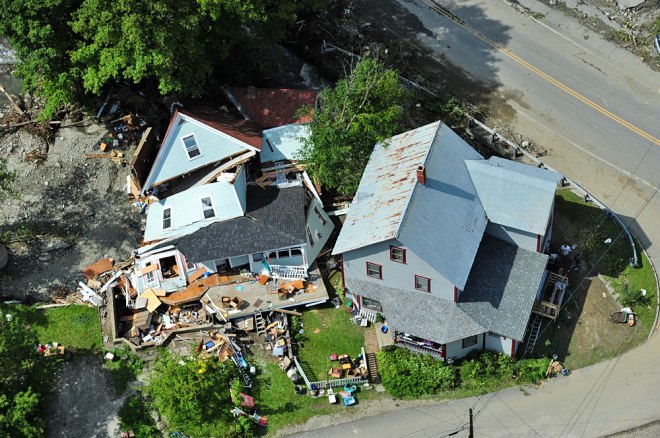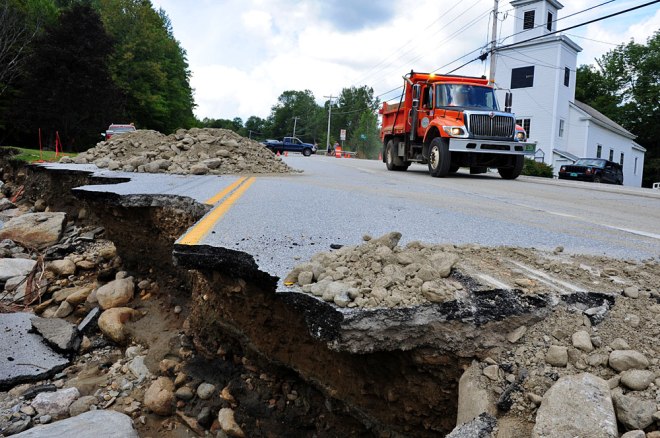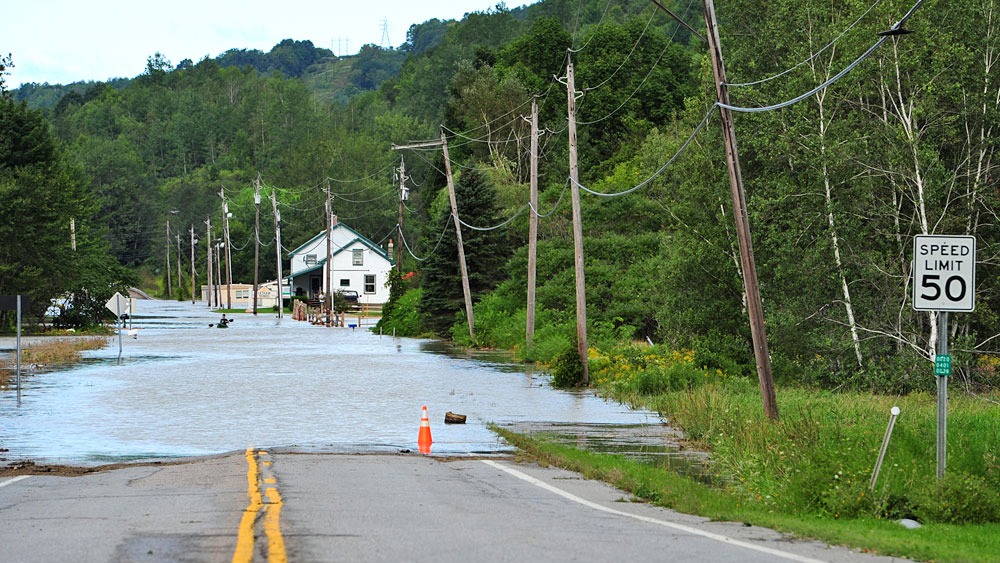Three years after Tropical Storm Irene turned their fields into lakes and their cows into swimmers, the owners of Liberty Hill Farm are planting sunflowers, creating beauty where they once saw devastation.
Beth Kennett’s eyes still flood with tears as she and her husband, Bob, recall the volunteers — strangers, mostly — who streamed into town during the late summer of 2011 to help save its last remaining dairy farm. With well over a million dollars’ worth of damage, “our farm wouldn’t exist” without volunteer labor, Beth says.
With its iconic red barn and the graphic punch of black and white cows against kelly green fields, Liberty Hill Farm is everything you envision when you picture a family farm. Nestled between steep hills along the White River in central Vermont, the 240-acre property is home to 270 Holstein cows. Everyone helps: the Kennetts’ grown sons, Tom and David, their daughters-in-law, and their five grandkids, including 2-year-old Ella, who trots after her father in her little bright pink rubber boots.
The simple pleasures of rural life — fresh air, clean water, honest labor, proximity to nature — are at their seductive best here, right down to the tire swing that hangs from the maple tree and the rhubarb coffee cake that cools on the stove.
But for the Kennetts and the 1,137 others in Rochester and countless communities like it — remote places with abundant beauty and meager resources — the outlook is clouded at best. In its most recent report released earlier this year, the National Climate Assessment (NCA) devoted an entire chapter to the increasingly detrimental effects of climate change on rural America: its infrastructure, economy, and overall quality of life.
Romanticizing farm life is easy; living it is hard. Like most of their neighbors, the Kennetts rely on more than one business to stay afloat. Spend a night in one of the seven guest rooms in the farmhouse that doubles as an inn, and pastoral fantasies fade with the milk truck that rumbles into the barnyard before dawn. That’s also about the time Beth, a ninth-generation farmer, starts prepping the hearty meals she puts on the table twice a day for paying guests who’ve been coming here for 30 years to satisfy their cravings for a taste of farm life.
There were 19 so-called “agri-tourists” on that fateful Sunday, Aug. 28, 2011. In the three hours it took Bob and his sons to move 100 frightened cows to higher ground, the ankle-deep water rose over their heads, cresting at 19 feet hillside to hillside, a distance of half a mile.
A brook that Beth’s 5-year-old grandson can jump without getting his feet wet went on a rampage and exhumed 60 graves from Woodlawn Cemetery just south of town.
Other streams behaved just as badly. Fed by up to 11 inches of rain, they rushed down the steep hillsides into the narrow valley, gaining momentum and destroying everything in their paths: homes, businesses, bridges, farmland, and roads. At the edge of the village, a mile or so upriver from Liberty Hill, Jon Graham was still in his Victorian house when the Brook Street Brook took out the ground underneath it. The house collapsed. He escaped, safe but traumatized.
“There are streams that aren’t streams — streams that had no water in them (before the storm) — that split houses in half,” said Kevin Geiger, senior planner with the Two Rivers-Ottauquechee Regional Commission. “You had streams you could step over carrying full-size trees.”
The next morning, the rain stopped, the sun came out, and the waters receded to reveal an alien landscape. There was no longer a road connecting Liberty Hill to Rt. 100, the only north-south road into town. The bridge at the intersection of Rt. 100 and Rt. 73, the only east-west road, was lying in the river like a boat launch, turning the western part of town into an island. Of the 13 Vermont communities Irene had left without a passable road in or out, six were in this valley, Rochester among them.

Makeshift walking bridge allows access to Route 100.Lars Gange / Mansfield Heliflight
When a stranded guest took Beth aside to ask what would happen when she ran out of food, she just looked at him, incredulous. “We’re a farm,” she said finally. “This is where food comes from.”
It’s a fact that bears repeating for the vast majority of Americans — 81 percent — who don’t live in rural areas but who are no less dependent on them, not only for food, but for water, forests, recreation, energy, natural amenities, and more.
With 95 percent of the nation’s land and just 19 percent of its people, rural America is a vast and varied place, a patchwork of plains, forests, deserts, shoreline, mountains, hills, and hollows. It’s bound not by geography, but by the economic and cultural relationships between its people and the land, what David Hales, a lead author of the NCA’s rural America chapter calls “the economic basis for how people give meaning to their lives and put food on the table.”
What happens in rural America affects all of America. And while “it is difficult to fully capture the complex interactions of the entire socio-economic-ecological system within which the effects of climate change will interact,” the report says, it’s easy to see why people whose fortunes are tied to the land are more vulnerable to volatile weather.
Extreme weather events will progressively increase over the century, the NCA report warns. For some rural areas, that will mean more severe heat waves, droughts, and wildfires; for others, rising sea levels, coastal erosion, and loss of wetlands.
Vermont can expect more storms like Irene, which killed six of its residents and damaged 3,500 homes and businesses, 500 miles of state roads and 200 bridges at an estimated cost of $733 million, equal to nearly two-thirds of the state’s annual general fund budget.
Along with higher temperatures, rural Vermonters are likely to experience a greater frequency of infectious diseases carried by mosquitoes and ticks. Because rural residents spend more time outdoors, their risk of exposure is higher.
They can also expect more rain, less snow, and fewer skiers, and more invasive pests like the emerald ash borer, an exotic beetle killing ash trees along a wide swath that includes Quebec, New York, New Hampshire, and Massachusetts, all of which border Vermont.
Sap streak disease, a fungus, is already threatening sugar maples, Vermont’s official state tree and the source of two major contributors to its economy: maple syrup and the fiery red foliage that draws leaf-peepers in droves every fall.
A lack of economic diversity, among the hallmarks of rural America, is very much in evidence here. Twenty-five years ago, there were a dozen dairy farms in Rochester. Now, there’s just Liberty Hill Farm, a couple of small beef producers, an equine retirement facility, and a berry farm. Maple syrup is produced here, too, but it’s considered a supplemental seasonal crop.
A book publisher, an industrial LED lighting manufacturer, and the local school are among Rochester’s biggest employers, along with property management firms that support the sizable population of second-home owners lured by the natural amenities that are Rochester’s greatest assets: the White River, an undammed 60-mile tributary of the Connecticut River, stocked with trout and popular for tubing and canoeing, and the forest, part of the Appalachian trail, and a Mecca for hikers and mountain bikers.
Local businesses have joined forces to promote the valley as a scenic byway for tourists. Potters, a dulcimer-maker, jewelry designers, and other craftspeople are sprinkled throughout the region. Rochester also has a lively fine and performing arts community, perhaps in part a legacy of Quarry Hill Creative Center, the 140-acre hill farm that’s considered Vermont’s oldest counter-culture community and artists’ retreat.
That alternative flavor lives on in entities like Alyssum, Inc., “An Alternative Respite and Peer-Hosted Approach to Mental Wellness,” and ASEA, “The first and only source of balanced stabilized Redox Signaling molecules outside the body.”
“Sip and relax, you’re on Green Mountain Time,” advises a sign at the Rochester Café. One of a handful of restaurants in the tiny town center, it boasts one of the last old-fashioned soda fountains in Vermont, a time warp helped along by the penny candy, wooden toys, and hand-knit socks for sale in the adjacent country store.
That timeless quality is at odds with the changes residents had begun noticing years before Irene. Winter came later and ended earlier, bringing less snow and more ice. Bob Kennett estimates his growing season has lengthened by two weeks. Geese and ducks that used to stay a week or two before heading south are now wintering here.

A destroyed house in Rochester, Vt.Lars Gange / Mansfield Heliflight
Beth Frock remembers the blissful tick-free summers of 20 years ago. “We’re seeing bugs we’ve never seen before,” she says. Her husband, Jon Graham, who grew up here, likens Rochester’s current climate to that of the Rutland of his youth, a place “we considered the tropics.” Rutland, Vermont’s third-largest city, is 20 miles south.
While people who live on rivers are used to floods, as Beth Kennett points out, the ones that occurred in June of 1998 and August of 2008 “were considered 50- to 100-year floods that happened 10 years apart.” The U.N. Intergovernmental Panel on Climate Change predicts that rain events in the Northeast that are now one-in-20 year events will occur every four to six years by 2100.
A recent analysis of national climatic data by the Associated Press found Vermont and Maine in a dead heat for the dubious distinction of fastest warming state, their temperatures having risen 2.5 degrees since 1984. “It’s almost as if the climate of Springfield, Mass., moved to Burlington, Vt.,” commented Vermont weather blogger Matt Sutkoski.
Three months before the storm that would become the defining event of his first term, Democratic Gov. Peter Shumlin established a Climate Cabinet of senior government officials to reduce greenhouse gas emissions and develop recommendations for how the federal government can better support states and communities preparing for climate change impacts.
“The goal,” according to cabinet chair Deb Markowitz, secretary of the Vermont Agency of Natural Resources, “is to help our communities evaluate where they are most vulnerable, site and build resilient infrastructure, and protect natural assets — whether floodplains, river corridors, upland forests, or coastal dunes — that protect our built communities from damage caused by extreme weather.”
When devastating flooding occurred in Colorado two years after Irene hit Vermont, Markowitz offered a few critical lessons to her Rocky Mountain counterparts: Sleep and eat, ask for help, communicate, and build back with resilience in mind.
The National Climate Assessment lists geographic isolation, a stressed infrastructure and limited healthcare among the obstacles rural communities face in trying to prepare for and respond to climate risks. All were immediately apparent in Rochester in the aftermath of Tropical Storm Irene.
Access to healthcare declines as geographic isolation increases, the NCA report notes. “Overall, rural residents already have higher rates of age-adjusted mortality, disability, and chronic disease than do urban populations. These trends are likely to be exacerbated by climate change.”
In a report on trends in rural and small-town America, demographer Kenneth Johnson of the Carsey Institute at the University of New Hampshire notes that large metropolitan counties have nearly four times as many doctors per 100,000 residents as do rural counties with only small towns. Rural counties have one-sixth as many specialists.
The higher fatality rates in rural areas for infants, young adults, middle-aged adults, and motor vehicle accident victims “is a sober reminder that where you live sometimes determines whether you live,” Johnson says.
Even without flooded roads and washed-out bridges, Rochester residents who call 911 can face a 20-minute wait for the nearest ambulance to arrive from Bethel, 12 miles away. The situation is unlikely to change anytime soon. Larry Straus, head of the Rochester Select Board, considers it “part of the risk of living in an isolated area.”
Town Clerk Joanne McDonnell considers it a time bomb. “Unfortunately, someone’s going to die,” she says, “and it’ll hit the fan.”
In areas with limited services and a strong reliance on volunteers, Hales says, sophisticated leadership “makes a great difference. If it isn’t there, or it’s so stretched it can’t respond, things are much worse.”
By all accounts, the tone for Rochester’s recovery from Irene was set early on by Selectman Straus, who began holding daily town-wide meetings within 24 hours. At the first one, townspeople identified four residents who needed dialysis and nine more in urgent need of medications. By the following day, the nine had become 25.
Via a chain of helicopters, four-wheelers, and hikers, the necessary medicines were brought in and the dialysis patients flown out.
“The effects of climate change on mental healthcare merit special consideration,” according to the NCA report. “Rural residents are already at a heightened risk from mental illness because of the lack of access to mental health providers. The adverse effect of severe weather disasters on mental health is well established …”
One Rochester resident, a military veteran, suffered a severe episode of PTSD upon hearing the medical helicopters. Additional rain triggered widespread anxiety, particularly among children. Beth Frock, who with husband Jon Graham watched their house collapse, calls 2011 “The Lost Year. All of us got out of bed and went to work, but that’s about all. We were numb.”
In the aftermath of the storm, those who were able took stock. Six bridges in the immediate area and 14 in a circle around the town were out. An electrical substation was on its side, so no one without a generator had power. Phone service was nonexistent. Sections of Route 100 north and south of Rochester Village had washed out, along with many other two-lane main roads.

Route 4 / Route 100 south of Killington completely destroyed.Lars Gange / Mansfield Heliflight
“Stuff that only happens on TV, it had all happened,” Joanne McDonnell says.
But in the days and weeks that followed, Rochester residents did what rural folks do best: In countless ways large and small, they rescued themselves and each other.
“People didn’t wait for the cavalry,” says Straus. “People stepped up.”
With tractors and backhoes, people went to work on the roads and the streams. On either side of the washed-out bridge on Rt. 73, residents donated lumber, plywood, nails, and tools and built a footbridge. West Rochester was an island no more.
The Huntington House Inn, The Rochester Café, The Village Porch, and other local restaurants took turns preparing community meals. Anyone who had food thawing shared it. The guys from the Skip Mart handed out boxes of candy to repair crews who worked around the clock to get the lights on and the phones working. The school became a shelter serving three meals a day under the supervision of hot lunch chef Kristi Fuller.
“That kind of isolation tends to breed a pretty hardy group,” Hales says. “They’re accustomed to change. They’ve seen blizzards. They’ve seen forest fires. They have a wide range of sustainability skills if not survival skills.”
In Rochester, people had both.
In addition to the backbreaking chores that go along with cleaning up after a flood, there was music in the park, a barbeque for 60 at Liberty Hill Farm, and a bullhorn for Straus, whose voice grew hoarse with exhaustion. The community pulled together like never before. It was a heady time, one that people still speak of with a mixture of pride and amazement.
On Wednesday night, three days after the flood, the first volunteers began arriving, having four-wheeled over the mountain because they’d seen on Facebook that the Kennetts needed help.
Many more filtered in after that. They hiked in with backpacks and rode in on mountain bikes. They came from Maine, New Hampshire, Massachusetts, Rhode Island, and parts of Vermont that Irene had spared. And still more came from New York and New Jersey, Pennsylvania and Montana, Louisiana and Minnesota.
Central Vermont Public Service (CVPS) dispatched an unprecedented lineup of 140 trucks and nearly 600 contractors. By Thursday night, CVPS had restored power to most of the town. Mail and phone service resumed the same day.
The National Forest Service, stewards of the Green Mountain National Forest that surrounds Rochester, brought in extra personnel, helicopters, and equipment. “They were phenomenal partners,” Beth Kennett says.
Betsy Greene, equine extension specialist at the University of Vermont, brought in feed for the valley’s horses. Heather Darby, a UVM soils specialist who grew up on a dairy farm, came with her students to help the Kennetts assess the condition of their fields.
Together, the volunteers and townspeople put right what the storm had undone: moving boulders and tree trunks, and shoveling silt out of barns and mud out of living rooms. While hundreds rolled up their sleeves, many more got out their checkbooks.
Other farmers sent truckloads of hay and silage to the Kennetts, who’d lost 85 percent of their feed for the coming year. It took six days for the milk truck to reach them; until it did, they had to dump 800 gallons of fresh milk a day. Cabot Creamery, the 1,200-farm cooperative they belong to, paid them for every gallon.
“By the end of the first two weeks, everyone had pitched in,” Straus says. “People talked to people they’d never talked to in their lives. Kids mucked out basements. My only regret is that I never got to help an individual clean out their house.” He was too busy managing the town’s various projects to repair roads, bridges, the ball field, the cemetery and more. Ultimately, there were 65 individual Federal Emergency Management Agency (FEMA) projects.
The Vermont Agency of Natural Resources allowed people to work in streams with heavy equipment after receiving verbal approval from state river engineers. But there have since been complaints that the temporary emergency rules created a “lawless state” that had crews digging gravel from stream beds, altering channels, damaging fish habitat, and possibly worsening future floods.
Despite all the work that was done, Straus says Rochester’s infrastructure “is just as vulnerable as it was in 2011, aside from a few culverts and bridges. Could it all happen again? Sure.”
Hales acknowledges that the rural culture of self-reliance “is a little bit of a two-edged sword. Whoever’s going to replace that culvert will replace it with one the same size because they don’t want to wait for the experts. The problem is that they haven’t shifted their questions to ask the right one: What’s likely to have to go through that culvert in the next 5 or 10 years?”
In an op-ed piece a week after the release of the NCA report, Deb Markowitz wrote that “urgent action is needed to combat the threats of climate change and to ensure that our families and communities are resilient to these threats.”
A month later, Vermont became the first state to publish its own climate assessment, in which Gillian Galford, the lead author and University of Vermont climate scientist, noted that Vermont’s climate has already changed, and that more heavy downpours and catastrophic flooding lie ahead. “We have to build resilience,” she said.
To that end, Vermont officials asked the federal government for public assistance money to rebuild to higher standards, replacing the culverts that failed during Irene with bigger, more environmentally sound ones that would allow streams to pass beneath roads instead of washing them out.
“We want to build stuff that’s going to withstand the next flood,” says Ben Rose of Vermont Emergency Management and Homeland Security, who worked with local and federal officials to secure funding.
In July, however, after having concluded that Vermont’s engineering plans fail to meet current federal uniform codes and standards, FEMA denied the request.
Additional heavy downpours continue to damage Vermont’s infrastructure three years after Tropical Storm Irene.




